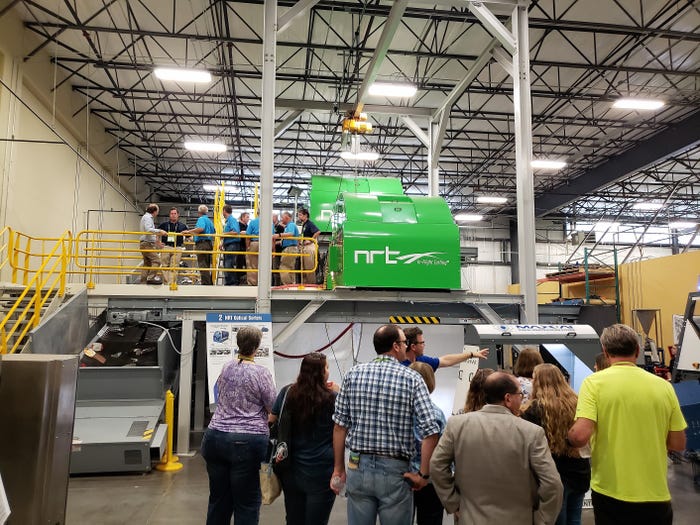Behind the Scenes of NRT’s Nashville Headquarters
NRT, a subsidiary of BHS, is focused on technology innovation, quality of manufacturing and a strong commitment to customer service.

The Solid Waste Association of North America (SWANA) kicked off its largest event, WASTECON, in Nashville on Monday with an afternoon of site tours. The tours, which were hosted by companies like Aries Clean Energy, Second Harvest and Bulk Handling Systems (BHS), gave show attendees a chance to see how equipment and facilities operate.
National Recovery Technologies (NRT), a subsidiary of BHS focused on technology innovation, quality of manufacturing and a strong commitment to customer service, gave a tour at its headquarters. The tour included a detailed explanation of some of NRT’s equipment and live demonstrations of the company’s optical sorting demonstration loop, the Max-AI AQC (Autonomous Quality Control) and Buhler SORTEX flake sorters.
NRT’s optical sorters are in use throughout the world on nearly every continent and designed for performance, with internal controls, user-friendly HMI, sealed cooling, maintenance-friendly ejector block and clear, dual-access doors. The sorters also feature In-Flight Sorting technology, which detects and ejects materials in flight, eliminates motion-related error and belt interference, enables transmissive detection for 100 times stronger signal on wet and thin-walled PET and has auto-calibration to maintain peak performance and eliminate downtime due to calibration issues.
All of NRT’s proprietary sorting technology is designed in-house and used in BHS systems to sort a variety of materials, including plastics, metals, cardboard, paper, wood, glass, inerts and other materials. This technology is part of BHS’ overall vision to create materials recovery facilities (MRFs) that run autonomously void of human sorters.
The Max-AI AQC is a technology that virtually acts and thinks like a human. A completely autonomous, high-volume recovery solution, Max-AI AQC exceeds human capabilities in every metric, including pick rate, accuracy and uptime, and sustains those capabilities every minute of the day.
“NRT is continuing to roll out applications for Max-AI technology, including integrating these innovative detection capabilities into optical sorters,” says Peter Raschio, marketing manager for BHS. “The company is also developing the Total Intelligence Platform to provide operators with the information they need to make profitable decisions. Performance and KPI analytics are delivered in real time and trending.”
The Buhler SORTEX PolyVision technology performs transparent and reflective sorting simultaneously and removes polymer contaminants in PET processing. It also removes subtle color defects and foreign materials, maintains consistent performance via auto-calibration and product tracking and comes in three different frame sizes in the MultiVision, ColorVision and DualVision technology variants.
All of these technologies, in addition to an aforementioned vision, are major drivers for NRT.
“The waste and recycling industry has been less automated than other production industries due to the unpredictability of the material stream,” says Raschio. "Max-AI technology’s machine vision is able to make sense of this indiscriminate combination of materials and is really redefining what is possible in our MRFs. Customers always need to make higher-quality products and with a higher ROI. NRT is working to decrease operating costs, increase performance and usher in a new level of system automation and intelligence.”
One example of NRT’s innovative equipment rising to the challenge can be found in Norsk Gjenvinning's Oslo, Norway, system, which features NRT SpydIR optical sorters to positively eject fiber products. NRT ColorPlus optical sorters are then used to remove cardboard. With dedicated steps for each ejection, this design not only creates a high-quality paper product but also ensures cardboard recovery. Max-AI AQC robotic sorters accomplish a completely automated quality control, removing any remaining contaminants.
Max-AI technology is also used, through Max-AI VIS (Visual Identification System) units, to certify the quality of the outbound paper product. This system addresses current problems with contaminated bales by producing an extremely high-quality paper product and reporting exactly how pure that product is (something that the customer can monitor and also share with customers).
To get a visual understanding of this equipment and technology, check out this gallery of NRT’s Nashville headquarters.
About the Author(s)
You May Also Like




